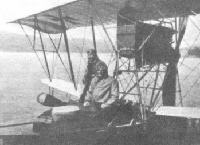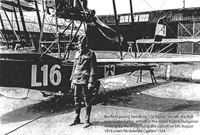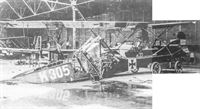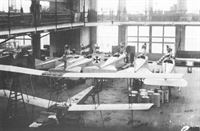
Описание
Страна: Австро-Венгрия
Год: 1914
Reconnaissance
Варианты
- Lohner - E/L/M/R/T - 1914 - Австро-Венгрия
- Macchi - L.1/ L.2 / M.3 - 1915 - Италия
- В.Обухович, А.Никифоров Самолеты Первой Мировой войны
- А.Александров, Г.Петров Крылатые пленники России
- E.Hauke, W.Schroeder, B.Totschinger Die Flugzeuge der k.u.k. Luftfahrtruppe und Seeflieger 1914-1918
- Журнал Flight
-
A.Olejko - Habsburg Wings 1915 /Aeronaut/
Lohner M E21
-
D.Mechin - Foreign Fronts of the French Air Force 1914-1919 /Aeronaut/
A lonely but deadly opponent, the Lohner L 16 of Gottfried Banfield based in Trieste who shot down 3 French flying boats.
-
E.Hauke, W.Schroeder, B.Totschinger - Die Flugzeuge der k.u.k. Luftfahrtruppe und Seeflieger 1914-1918
Löhner M L 16 Gottfried Banfield Triest Juni 1916
-
A.Olejko - Habsburg Wings 1915 /Aeronaut/
Lohner Type 'T' L47
-
E.Hauke, W.Schroeder, B.Totschinger - Die Flugzeuge der k.u.k. Luftfahrtruppe und Seeflieger 1914-1918
Löhner T L 47 Triest April 1916
-
E.Hauke, W.Schroeder, B.Totschinger - Die Flugzeuge der k.u.k. Luftfahrtruppe und Seeflieger 1914-1918
Löhner Te L 59 Santa Catharina Oktober 1915
-
A.Olejko - Habsburg Wings 1915 /Aeronaut/
Lohner L131
-
A.Olejko - Habsburg Wings 1915 /Aeronaut/
Lohner L135
-
E.Hauke, W.Schroeder, B.Totschinger - Die Flugzeuge der k.u.k. Luftfahrtruppe und Seeflieger 1914-1918
Löhner TI L 135 Kumbor September 1916
-
J.Davilla - Italian Aviation in the First World War. Vol.3: Aircraft M-W /Centennial Perspective/ (75)
Captured Lohner L 40 in Italian service
-
J.Davilla - Italian Aviation in the First World War. Vol.1: Operations /Centennial Perspective/ (73)
Lohner L127 preserved in a museum shows its Austro-Hungarian naval colors and markings.
-
J.Davilla - Italian Aviation in the First World War. Vol.1: Operations /Centennial Perspective/ (73)
Lohner L127 in the museum wears the name MANI on its nose above the national insignia. The national insignia painted on the nose to be viewed from in front if the aircraft was started by the Austrians and adapted by Italy.
-
R.Gentilli - Italian Aviation Units in the First World War. Vol.4 /Aeronaut/ (4)
Lohner L127 as it appears in the recently renovated Historical Museum of the Italian Air Force at Vigna di Valle, near Rome.
-
E.Hauke, W.Schroeder, B.Totschinger - Die Flugzeuge der k.u.k. Luftfahrtruppe und Seeflieger 1914-1918
Seeflugzeug E 16, Type Etrich/Mickl in Abhazia, 16. Jänner 1914. Lsehlt Wenzel Wosecek steht neben dem Motor
-
A.Olejko - Habsburg Wings 1915 /Aeronaut/
16 October 1914, piloting a flying boat type Lohner M E 17 Linien Schiffsleutnant Hugo Ockermuller carried out bombing and shelling targets in Kuksattel and attacked the radio station of the Montenegrin army while being shelled by a Montenegrin opl... The photo shows a Lohner M E 17 flying boat from Flotten Flug Abteilung Kotor moored in Kumbor. source: B. Ciglic, Seaplanes of Bocche. The Story of Austro-Hungarian Naval Aviation in Southern Adriatic 1913-1918, Beograd 2014
-
A.Olejko - Habsburg Wings 1915 /Aeronaut/
November 2, 1914 because of heavy artillery fire of the Montenegrin opl. from Mount Ratec and from the artillery battery stationed in the Drzak area, the shrapnel damaged a flying boat type Lohner M E 17... The photo shows this seaplane after launching at the Flotten Flug Abteilung base in Kotor Bay. source: B. Ciglic. Seaplanes of Bocche. The Story of Austro-Hungarian Naval Aviation in Southern Adriatic 1913-1918, Beograd 2014 (via B. Kudlicka, P. Plattner)
-
A.Olejko - Habsburg Wings 1915 /Aeronaut/
As a result of a strong south-west wind (Bora) and a storm up to 8° on the Beaufort scale, the Flotten Flug Abteilung hangar in Kumbor was destroyed, and the three Lohner M E 17 and Lohner Mn E 34 and E 35 flying boats which were in it, got seriously damaged... The photo shows the damage done to the Flotten Flug Abteilung base - source: B. Ciglic, Seaplanes of Bocche. The story of Austro-Hungarian Naval Aviation in Southern Adriatic 1913-1918, Beograd 2014 (via B. Kudlicka, P. Plattner)
-
D.Mechin - Oriental Adventures of the French Air force 1914-1918 /Aeronaut/
One of the first opponents of the French, Lohner E-18 flown by Frglt. Konstantin Maglic. (Coll. Paolo Varriale)
-
A.Olejko - Habsburg Wings 1915 /Aeronaut/
One of the "Habsburg sea eagles"... Fregattenleutnant Konstantin Maglic (in the cabin of a Lohner M E 21 (???) flying boat) On October 31, 1914, he was awarded a high distinction of the Imperial-Royal Army Signum Laudis (German Militarverdienstmedaille) for combat flights over the Montenegrin coast in the campaign 1914 - source: B. Ciglic, Seaplanes of Bocche. The Story of Austro-Hungarian Naval Aviation in Southern Adriatic 1913-1918, Beograd 2014 (via J. Zahalka)
-
A.Olejko - Habsburg Wings 1915 /Aeronaut/
The strength of Bora September 14, 1914... In the photo the sailors of the Flotten Flug Abteilung Kotor next to the Lohner M E 18 flying boat damaged by a strong storm and two tent hangars destroyed by the storm, source: B. Ciglic, Seaplanes of Bocche. The Story of Austro-Hungarian Naval Aviation in Southern Adriatic 1913-1918, Beograd 2014
-
E.Hauke, W.Schroeder, B.Totschinger - Die Flugzeuge der k.u.k. Luftfahrtruppe und Seeflieger 1914-1918
Seeflugzeug E 19, Type Etrich/Mickl im Hangar, Seeflugstation S. Catharina in der Bucht von Pola
-
A.Olejko - Habsburg Wings 1915 /Aeronaut/
FIotten Flug Abteilung Kotor... As of August 1, 1914, there were three Lohner M flying boats E 18, E 20, and E 21 in the state of the vessel... In the photo, flying boat E 20 in a transport trolley, taken out from a tent hangar and prepared for launch by the ground staff of Flotten Flug Abteilung Kotor - Source: B. Ciglic, Seaplanes of Bocche. The Story of Austro-Hungarian Naval Aviation in Southern Adriatic 1913-1918, Beograd 2014The Lohner E 20 being put to water. This plane, flown by Frglt. Gottfried Banfield, met French Voisin V 6 in flight on September 16, 1914, but did not engage combat. (Collection Paolo Varriale)
-
A.Olejko - Habsburg Wings 1915 /Aeronaut/
On June 28 and 29, 1914, three Lohner M flying boats E 18, E 20, and E 21 were used for flights (the crews - there were artillery officers on board as observers - they also recognized the area of the Montenegrin port in Bar)... In the photo there is a Lohner M no. E 20 flying boat from Flotten Flug Abteilung Kotor in a transport cart during its launch into the waters of the Bay of Kotor by the ground personnel of the unit - source: B. Ciglic, Seaplanes of Bocche. The Story of Austro-Hungarian Naval Aviation in Southern Adriatic 1913-1918, Beograd 2014
-
A.Olejko - Habsburg Wings 1915 /Aeronaut/
In the waters of the Bay of Kotor... In the photo there is a Lohner M no. E 20 flying boat during preparation for flight by Flotten Flug Abteilung Kotor ground staff - source: B. Ciglic, Seaplanes of Bocche. The Story of Austro-Hungarian Naval Aviation in Southern Adriatic 1913-1918, Beograd 2014 (via B. Kudlicka, P. Plattner)
-
A.Olejko - Habsburg Wings 1915 /Aeronaut/
On March 23, 1913, a makeshift air station was opened in Tivat in the Bay of Kotor which was operating until May 28,1913, headed by Linien Schiffsleutnant V. Wosecek... The photo shows the pilot in the cabin of a Lohner M E 21 flying boat just before taking off from the waters of the Bay of Kotor, source: B. Ciglic, Seaplanes of Bocche. The Story of Austro-Hungarian Naval Aviation in Southern Adriatic 1913-1918, Beograd 2014 (via J. Zahalka)
-
D.Mechin - Oriental Adventures of the French Air force 1914-1918 /Aeronaut/
All of the Austro-Hungarian airforce - 3 seaplanes - shown on this photo. (Collection Paolo Varriale)
-
A.Olejko - Habsburg Wings 1915 /Aeronaut/
On October 16-20, 1914, the crew of a Lohner Mn E 33 type flying boat consisting of Fregattenleutnant G. Prebanda and Fregattenleutnant H. Fontaine von Felsenbrunn performed reconnaissance the area of Ulcinj... In the photo a Lohner Mn E 33 flying boat from Flotten Flug Abteilung Kotor moored at the shore Kotor Bay. source: B. Ciglic, Seaplanes of Bocche. The Story of Austro-Hungarian Naval Aviation in Southern Adriatic 1913-1918, Beograd 2014 (via C. Janie)
-
J.Davilla - Italian Aviation in the First World War. Vol.1: Operations /Centennial Perspective/ (73)
Lohner E33 afloat at Cattaro
-
A.Olejko - Habsburg Wings 1915 /Aeronaut/
The golden hands of mechanics... In the photo a Lohner Mn E 33 flying boat moored at the shore of the Bay of Kotor during the inspection carried out by the mechanics of the vessel, source: B. Ciglic, Seaplanes of Bocche. The Story of Austro-Hungarian Naval Aviation in Southern Adriatic 1913-1918, Beograd 2014 (via C. Janie)
-
E.Hauke, W.Schroeder, B.Totschinger - Die Flugzeuge der k.u.k. Luftfahrtruppe und Seeflieger 1914-1918
Seeflugzeug E 37, Type Mn im Seeflugstützpunkt Kumbor
-
E.Hauke, W.Schroeder, B.Totschinger - Die Flugzeuge der k.u.k. Luftfahrtruppe und Seeflieger 1914-1918
Seeflugzeug M 31, Type Mk, ausgerüstet mit Mercedes 100 PS, Vorbereitungen zum Start in Kumbor, 1915
-
J.Davilla - Italian Aviation in the First World War. Vol.1: Operations /Centennial Perspective/ (73)
Banfield posing beside his L16 fighter aircraft, the first specialized fighter aircraft in the entire Austro-Hungarian military. Banfield was flying this aircraft on 6th August 1916 when he downed Caproni 1134.
-
E.Hauke, W.Schroeder, B.Totschinger - Die Flugzeuge der k.u.k. Luftfahrtruppe und Seeflieger 1914-1918
Seeflugzeug L 16, Type Löhner M, am Gelände der Lohnerfabrik, August 1914, vor Ablieferung an die Marine
Гидросамолет L 16, тип Löhner M, на территории завода Lohner, август 1914 г., перед поставкой на флот -
D.Mechin - Foreign Fronts of the French Air Force 1914-1919 /Aeronaut/
Banfield's Lohner L 16 fighter, moored at its quay in Trieste (Paolo Varriale)
-
D.Mechin - Foreign Fronts of the French Air Force 1914-1919 /Aeronaut/
In January 1916, Gottfried Banfield recovered a seaplane designed for racing that he used as a single-seater fighter. Registered L 16, it would prove to be a formidable opponent to French and Italian aviation. (Paolo Varriale)
-
E.Hauke, W.Schroeder, B.Totschinger - Die Flugzeuge der k.u.k. Luftfahrtruppe und Seeflieger 1914-1918
Seeflugzeug L 32, Type Lohner/Warnemünde in Kuinbor an Land, März 1915
-
R.Gentilli - Italian Aviation Units in the First World War. Vol.1 /Aeronaut/ (1)
The Austrian Lohner L.40 that fell in Italian hands and was copied by Macchi, here at Porto Corsini; behind it parts of a Borel monoplane can be seen (USMM)
-
E.Hauke, W.Schroeder, B.Totschinger - Die Flugzeuge der k.u.k. Luftfahrtruppe und Seeflieger 1914-1918
Seeflugzeug L 45, Type L in Kumbor, Juni 1915, davor stehend Lschlt Franz Mikuleczky und Lschlt i.d.Res. Alois Poljanec
-
E.Hauke, W.Schroeder, B.Totschinger - Die Flugzeuge der k.u.k. Luftfahrtruppe und Seeflieger 1914-1918
Seeflugzeug L 45, Type L als Schulflugzeug in Pola, Havarie nach Motordefekt, 3. Mai 1917, Lschlt Jakob Sturm unverletzt
-
J.Davilla - Italian Aviation in the First World War. Vol.1: Operations /Centennial Perspective/ (73)
Closeup of Lohner L47. These flying boats had an insignia on the nose in addition to the normal locations.
-
E.Hauke, W.Schroeder, B.Totschinger - Die Flugzeuge der k.u.k. Luftfahrtruppe und Seeflieger 1914-1918
Lohner flying-boat of the Austrian Navy. Although never strong in numbers, the Austrian naval aviators dominated air operations in the Adriatic.
Seeflugzeug L 47, Type T in Grado am 18. April 1916, Flugzeug ging am 17. April beschädigt vor Grado nieder, Besatzung Frglt Ernst Freiherr von Schönberger und EF Franz Hrdina gefangen, L 47 erbeutet
Гидросамолет L 47, Type T в Градо 18 апреля 1916 г., самолет упал, поврежденный 17 апреля перед Градо, экипаж Frglt Ernst Freiherr von Schönberger и EF Franz Hrdina захвачен, L 47 захвачен -
D.Mechin - Foreign Fronts of the French Air Force 1914-1919 /Aeronaut/
View of Lohner L 59, which left Pola with 5 other similar aircraft to raid Venice. Its pilot, Linienschiffleutnant Demeter Konjovics, with Linienschiffleutnant Hugo Stenta as observer, returned to its base heavily damaged by the fire of Lachmann's Nieuport according to the Austrian archives (Paolo Varriale)
Seeflugzeug L 59, Type Te, Seeflugstation S. Catharina. Herbst 1915. davor stehend Lschlt Demeter Konjovic
Гидросамолет L 59, Type Te, база гидросамолетов S. Catharina. Осень 1915 года. Перед ним Lschlt Demeter Konjovic -
E.Hauke, W.Schroeder, B.Totschinger - Die Flugzeuge der k.u.k. Luftfahrtruppe und Seeflieger 1914-1918
Seeflugzeug L 60, Type Te. Seeflugstation Kumbor, Frühjahr 1916. Die Nummer 23 war als Stationsbezeichnung verwendet worden, wie 21 L 58
Гидросамолет L 60, Type Te. Морская летная станция Кумбор, весна 1916 года. Число 23 использовалось в качестве названия станции, например, 21 L 58. -
E.Hauke, W.Schroeder, B.Totschinger - Die Flugzeuge der k.u.k. Luftfahrtruppe und Seeflieger 1914-1918
Seeflugzeug L 62, Type Te, Seeflugstation Kumbor, Frühjahr 1916. Der Hangar ist mit aufgemalten Bäumen getarnt, als „Mimikry“ bezeichnet
Гидросамолет L 62, Type Te, База гидросамолетов Кумбор, весна 1916 года. Ангар замаскирован нарисованными деревьями, что называется «мимикрия». -
E.Hauke, W.Schroeder, B.Totschinger - Die Flugzeuge der k.u.k. Luftfahrtruppe und Seeflieger 1914-1918
Seeflugzeug L 65, Type Te, Seeflugstation S. Catharina, 4. April 1916, dahinter L 74. Vor dem Flugzeug Skdt Ludwig Vamos, Lschlt Hugo Stenta und FlMst Johann Molnar (von links)
Гидросамолет L 65, Type Te, станция Seeflugstation S. Catharina, 4 апреля 1916 г., за ней L 74. Перед самолетом Skdt Ludwig Vamos, Lschlt Hugo Stenta и FlMst Johann Molnar (слева направо) -
R.Gentilli - Italian Aviation Units in the First World War. Vol.3 /Aeronaut/ (3)
The Austrian seaplane Lohner L71 from Pola was captured during a large raid on Ancona on 3 April 1916. Other seaplanes took its crew to safety.
-
E.Hauke, W.Schroeder, B.Totschinger - Die Flugzeuge der k.u.k. Luftfahrtruppe und Seeflieger 1914-1918
Seeflugzeug L 75, Type Te, Seeflugstation Triest 1917, beim Anlaufen zum Start in der Baia di Muggia
-
H.Cowin - Aviation Pioneers /Osprey/
The Lohner Type L two seater reconnaissance/bomber flying boat was used to real effect by the Austro-Hungarian Navy during the 1915-1916 period. Based on Jakob Lohner's 1913 Type E, the Type L was powered by various engines rated between 140hp and 180hp, giving the machine a top level speed of around 65mph. Thanks to its wing design, the Type L showed an impressive high altitude capability, having a ceiling of about 16,400 feet. Around 160 Type Ls were built, but such was their operational success that the machine was copied by Macchi in Italy, leading to the Macchi M.3 through M.9 series.
-
C.Owers - Hansa-Brandenburg Aircraft of WWI. Volume 2 - Biplane Seaplanes /Centennial Perspective/ (18)
The remains of K305 after it crashed during takeoff while piloted by Lschlt. Hugo Stenta, 25 April 1917. The hull is still fairly well intact, a tribute to the Brandenburg form of construction. Brandenburg CC A33 and Lohner TI L102 are in the background.
Другие самолёты на фотографии: Hansa-Brandenburg CC - Германия - 1916Hansa-Brandenburg W.13 - Германия - 1916
-
E.Hauke, W.Schroeder, B.Totschinger - Die Flugzeuge der k.u.k. Luftfahrtruppe und Seeflieger 1914-1918
Seeflugzeug L 126, Type TI, Seeflugstation Puntisella. 11. Mai 1917. Nach Motordefekt vor Pola niedergegangen und mit der Bespannung bis Rovigno gesegelt; davor stehend der Pilot FlMst Johann Carini
Гидросамолет L 126, тип TI, гидросамолетная станция Puntisella. 11 мая 1917 года. Приводнился перед Полой из-за отказа двигателя и отплыл с прикрытием в Ровиньо; перед самолетом пилот FlMst Иоганн Карини -
R.Gentilli - Italian Aviation Units in the First World War. Vol.4 /Aeronaut/ (4)
On 3 June 1918 two sailors of Italian ethnicity deserted from the small base of Lussino arriving to Fano with Lohner L127, which was then taken to Ancona, here it is seen with TV Briganti. L127 is now exhibited in the Italian Air Force Museum at Vigna di Valle.
-
E.Hauke, W.Schroeder, B.Totschinger - Die Flugzeuge der k.u.k. Luftfahrtruppe und Seeflieger 1914-1918
Seeflugzeug L 134, Type TI. Seeflugstation S. Catharina, Juli 1916; kurz danach verlegte die Maschine nach Kumbor
Гидросамолет L 134, тип TI. Морская летная станция С. Катарина, июль 1916 г .; вскоре после этого машина переехала в Кумбор. -
D.Mechin - Foreign Fronts of the French Air Force 1914-1919 /Aeronaut/
Another view of Austrian Lohner registered L 137. (Paolo Varriale)
-
D.Mechin - Foreign Fronts of the French Air Force 1914-1919 /Aeronaut/
Symbol of the naval aviation war fought by the French pilots, this Austrian Lohner registered L 137. Hit by a ship's flak, it had to land on the Adriatic where it was captured by a fast torpedo boat of the Italian Navy, a MAS. (Paolo Varriale)
-
D.Mechin - Foreign Fronts of the French Air Force 1914-1919 /Aeronaut/
First confirmed aerial victory of escadrille N 392, the Lohner L 138 shot down by Sous-Lieutenant Xavier Garros and Lieutenant Rene Robert. The Austrian seaplane landed in a swamp near Caorle, northeast of Venice, where its crew, composed of the Seekadet Frantz Viranyi and the observer Hoch, was captured by the soldiers of the guardia di finanza (Paolo Varriale)
-
R.Gentilli - Italian Aviation Units in the First World War. Vol.5 /Aeronaut/ (5)
Lohner L.1 159 serving as a trainer in Taranto. The pilot in the cockpit is the American Harold Kantner, later a designer and test pilot with Convair.
-
E.Hauke, W.Schroeder, B.Totschinger - Die Flugzeuge der k.u.k. Luftfahrtruppe und Seeflieger 1914-1918
The K.u.K. Seeflugzeug Type S with individual code sS 3 is a training flying boat [Schulflugboot] built by Albatros powered by a Stahlherz 80 hp rotary, which came into service on 16 January 1916. The caption gives that the picture shows Leutnant Banfield in Triest after an unsuccesfull action against a French aircraft on 14 March 1916. The ultra-sharp picture in the book clearly shows a machine gun in front of the pilot.
Seeflugzeug sS 3, Type Löhner P, Seeflugstation Triest. 14. März 1916, als Abwehrflugzeug mit einem MG-Muster 7/12, am Pilotensitz Lschlt Gottfried Banfield
Гидросамолет sS 3, тип Löhner P, Seeflugstation Trieste. 14 марта 1916 года, оборонительный самолет с пулеметом type 7/12, в кабине Lschlt Готфрид Банфилд. -
A.Olejko - Habsburg Wings 1915 /Aeronaut/
"Eagle of Trieste"... The photo shows the best naval aviator of Austro-Hungary Fregattenleutnant Gottfried Freiherr von Banfield in the cabin of a flying boat during its transport through the city streets - source: Fotoarchiv SAW-KA.
-
A.Olejko - Habsburg Wings 1915 /Aeronaut/
After launching ... KuK Seeflugwessen flying boat No. S 22 in the Brioni area - source: J. Butkiewicz collection.
-
E.Hauke, W.Schroeder, B.Totschinger - Die Flugzeuge der k.u.k. Luftfahrtruppe und Seeflieger 1914-1918
Seeflugzeug R 25, Type TI ,,Schützenboot“, Seeflugstation Triest
-
A.Olejko - Habsburg Wings 1915 /Aeronaut/
Another flight, another reconnaissance... In the photo a Lohner type flying boat in the colors of KuK Seeflugwessen during a flight over the waters of the Bay of Kotor - source: "Das interessante Blatt" 1916
-
A.Olejko - Habsburg Wings 1915 /Aeronaut/
Reconnaissance over the Adriatic... 1914. In the photo, a KuK Seeflugwessen, Lohner-type flying boat flying over the roadstead of the KuK Kriegsmarine base in Pula - source: Fotoarchiv SAW-KA.
-
D.Mechin - Foreign Fronts of the French Air Force 1914-1919 /Aeronaut/
View of a Lohner seaplane in flight over the lagoons of the Italian coast. This aircraft, the only one used by the Austrian Navy in 1915 and early 1916, was the main adversary of French fighters and seaplanes. (Paolo Varriale)
-
P.Grosz, G.Haddow, P.Shiemer - Austro-Hungarian Army Aircraft of World War One /Flying Machines/
The well-lit and spacious Lohner factory provides a backdrop for assembly of a Lohner flying boat and six B.VII series 17.3 Pfeilfliegers.
Другие самолёты на фотографии: Lohner B.V / B.VI / B.VII - Австро-Венгрия - 1915
-
A.Olejko - Habsburg Wings 1915 /Aeronaut/
Domination over the sea... A watercolor painting showing the sinking of the French submarine "Foucault" by the crew of the Lohner L-135 type flying boat in the Oblt composition on September 15, 1916. Walther Zelezny and Lt. baron Otto von Klimburg south of Punta d'Ostro. author's collection.
-
M.Dusing - German & Austro-Hungarian Aero Engines of WWI. Vol.3 /Centennial Perspective/ (66)
Advertisement Hiero 200 hp Type H aeroengine on Austro-Hungarian seaplane. [1916]
-
A.Olejko - Habsburg Wings 1915 /Aeronaut/
The reality of the Adriatic air war in 1916... On February 2, 1916, the crews of three Lohner L 81 (Linienschiffsleutnant D. Konjovic and Linienschiffsleutnant J. Ritter von Ritschl), L 83 (Linienschiffsleutnant W. Hell and Linienschiffsleutnant M. Sewer) and L 82 (Linienschiffsleutnant K. Low) recognized the region of Valona falling into the strong fire of the Italian Opel in the port area and over the island of Saseno and still carrying out bombing targets. As a result of the fire of the opl Lohner L 83 flying boat had to forcibly launch due to a damaged radiator. Right next to it, a Lohner L 81 flying boat was launched, the crew of which took the L 83 crew on board and, with a total of four pilots on board, happily reached the base in the Bay of Kotor. The photo shows the artist's vision of the rescue of the crew of a downed Lohner flying boat by another K.u.K. Seeflugwessen. source: ‘‘Das interessante Blatt" 1916
-
Журнал - Flight за 1918 г.
The wing-float used on the "K-301," an Austrian 3-seater flying boat of the Lohner type.
-
A.Olejko - Habsburg Wings 1915 /Aeronaut/
Lohner M E21
-
A.Olejko - Habsburg Wings 1915 /Aeronaut/
Lohner Type 'T' L47
В.Обухович, А.Никифоров Самолеты Первой Мировой войны
Фирма Якоба Лёнера выпустила первый самолет для морской авиации Австро-Венгрии еще в 1911 г. Это был период интенсивного развития военной авиации, и морское ведомство прилагало усилия, чтобы не отстать от веяния времени. В морской авиации Австро-Венгрии использовалось значительное количество самолетов. Однако все они были произведены фирмами, которые контролировались известным предпринимателем и бизнесменом Камилио Кастильоне. Якоб Лёнер, создавший ряд удачных поплавковых самолетов и летающих лодок, сумел поколебать лидирующее положение Кастильоне в поставках авиационной техники для морской авиации.
Перед войной главный конструктор фирмы "Якоб Лёнер Верке" Паулал разработал серию одномоторных летающих лодок под индексами "Е" и "L", которые применялись для морского патрулирования и разведки. Лёнер Е стала первой летающей лодкой фирмы. Она представляла собой деревянный биплан с однореданным корпусом. Хвостовое оперение было поднято над фюзеляжем и крепилось с помощью стоек и подкосов. В качестве силовой установки использовался двигатель Хиро (85 л. с.) с толкающим воздушным винтом. Было построено около 40 машин этой серии. Они применялись для разведки восточной части Адриатического моря.
Вскоре в производство были запущены более крупные летающие лодки серии L Образцом для серии стала лодка L-5, созданная в 1914 г. и оснащенная двигателем Бенц (160 л. с). Ее корпус был прямоугольным, однореданным и обшивался фанерой. В передней части размещалась кабина экипажа, который состоял из пилота и наблюдателя, сидевших рядом. За кабиной крепилась бипланная коробка крыльев, между которыми устанавливался двигатель с двухлопастным деревянным толкающим воздушным винтом. Бипланная коробка была усилена тремя парами стоек и растяжками. Элеронами оснащалось только верхнее крыло. На законцовках нижнего крыла крепились стабилизирующие деревянные поплавки. В январе 1915 г. в авиационных частях на шкворне рядом с наблюдателем стали устанавливать 8-мм пулемет "Шварцлозе".
На лодках Лёнера летал известный морской истребитель-ас Готфрид Банфельд. Он испытывал в боевой обстановке практически все новые летающие лодки Австро-Венгрии. Уже 2 сентября 1914 г. он сбросил с самолета серии Е несколько небольших бомб на войска противника в Черногории. Первую же воздушную победу Банфельд одержал на машине серии Т (она отличалась двигателем). За время войны Банфельд выполнил на летающих лодках около 400 боевых вылетов и сбил 20 самолетов противника.
Всего было произведено 123 машины различных вариантов с двигателями Мерседес, Хиро, Рапп.
ЛЕТНО-ТЕХНИЧЕСКИЕ ХАРАКТЕРИСТИКИ
Двигатель 1 х Хиро (160 л. с.)
Размеры:
размах х длина х высота 16,0 х 10,0 х 3,5 м
Площадь крыльев 10,85 м2
Вес:
пустого 859 кг
взлетный 1325 кг
Максимальная скорость 110 км/ч
Время набора высоты
1000 м 20 мин
Потолок 2000 м
Продолжительность полета 6 ч
Вооружение:
стрелковое 1 х 8-мм шкворневый пулемет "Шварцлозе"
Экипаж 2 чел.
Описание:












































































